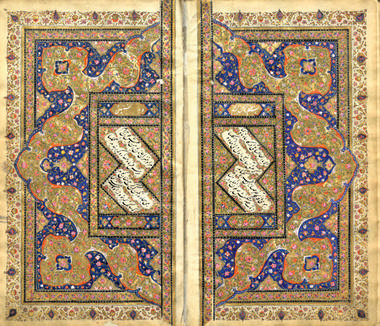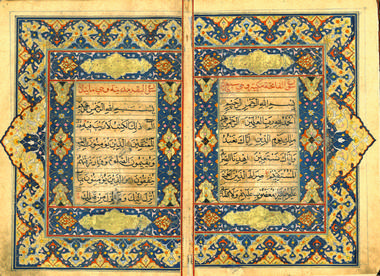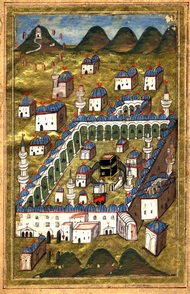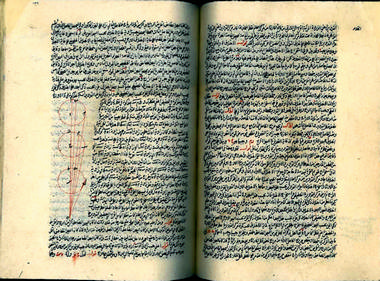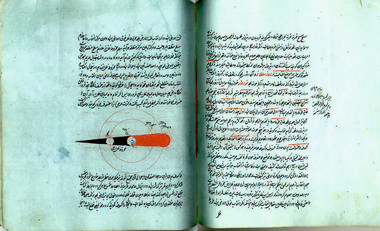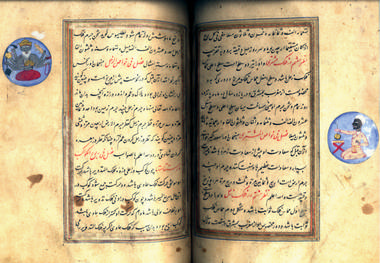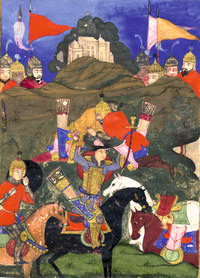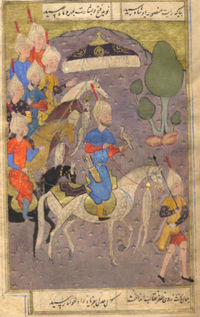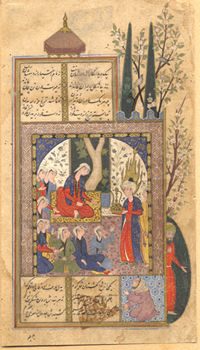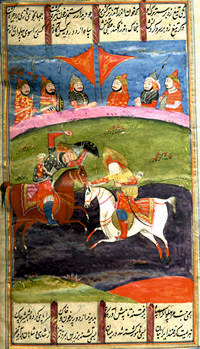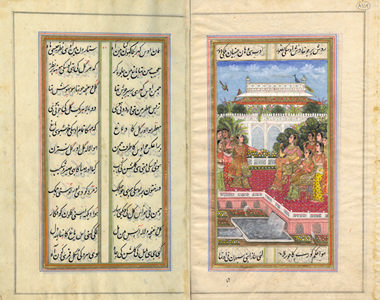Text quoted from:
Il manoscritto islamico - Un'introduzione
authors: A.Balistrieri G.Solmi D.Villani
Editore NOVACHARTA 2015
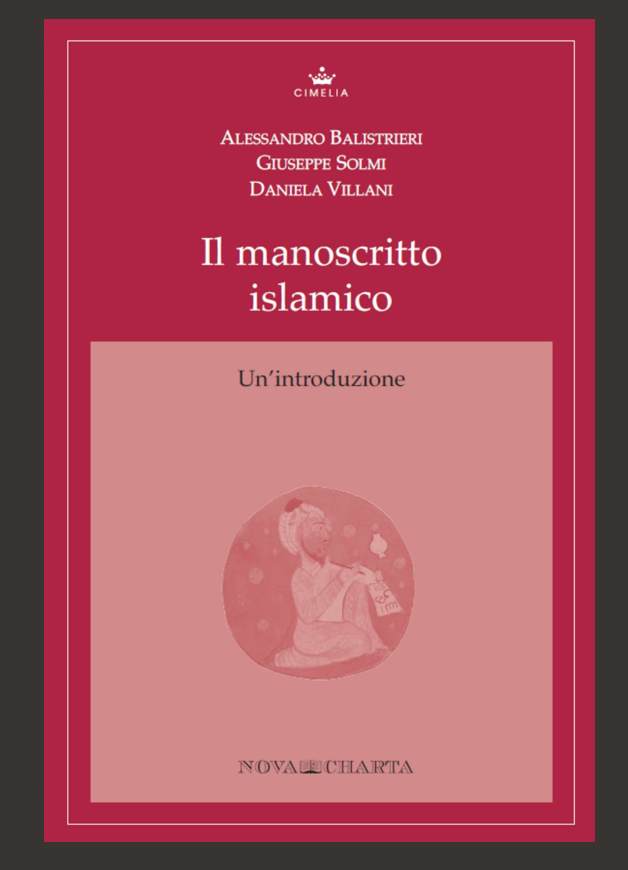
The Prophet
Muhammad, the prophet of Islam – in Arabic Muhammad, “The Most Praised One” -, was born and grew up in the caravan city of Mecca, in the Higaz region of the Arabian Peninsula. The exact year of his birth is unknown, yet he was certainly born around 570 AD. The only sure dates of his life are those of the Hegira - i.e., the emigration of the first believers to the city of Medina, then called Yatrib-, in 622 and that of his death in 632.
Muhammad was a member of the powerful Quraysh tribe, the de facto lords of Mecca. After a troubled early life, he married the wealthy widow Hadiga and after a few years began to retire to Mount Hira, in a cave not far from Mecca, where he used to meditate for long hours. Tradition has it that during one of these meditations, in the year 610 during the month of Ramaḍān, he received an apparition from the angel Gabriel, who persuaded him to become the Messenger of Allāh.
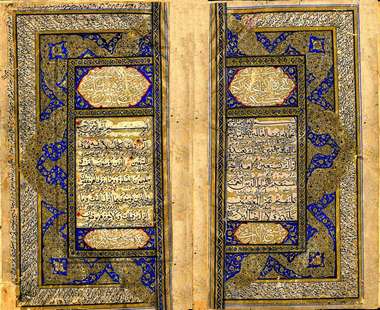
Towards the end of the year 612, Muhammad embarked on public preaching, encountering strong resistance from the Mecca rulers and common people. From 622 onwards, as he had moved to Medina along with his followers, Muhammad’s life was characterised not only by constant albeit fragmentary prophetic revelations, but also by a constant political effort to ensure peaceful coexistence between the community of converts and the inhabitants of Medina, to guarantee provisions for the oasis, to militarily organise his community and, in a word, to consolidate and reaffirm his position.
Finally, after several expeditions, Muhammad and the Muslim army conquered Mecca in AD 630.
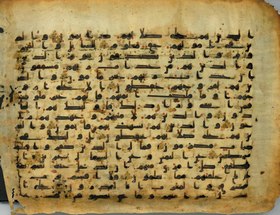
The pagan period of pre-Islamic Arabia will be defined in the Koran with the derogatory term Gahiliyya: “the age of ignorance”. The new religion, however, was obviously grafted onto the traditional Arab culture of that time. A perfect example of this is the cult of the Kaba, the “black stone” of Mecca, a fragment of an asteroid believed to be inhabited by some divine power, which even before Muhammad enjoyed deep veneration. In fact, the sanctuary previously dedicated to this stone has continued to be the most important place of Muslim pilgrimage to this day.
The Qur'an
The Qur'an is the holy book of the Islamic religion. All Muslims consider it 'the Book' par excellence, and most uphold the dogmas of its being immutable, inimitable and co-eternal with God.
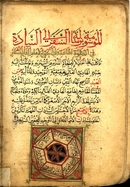

One of the most widely read, rewritten and reproduced texts in the history of mankind, the Qur’an has been deemed the worthiest book to be read, hand-written and handed down throughout the fourteen centuries of Islamic history. The best scribes in the whole Islamic ecumene have thus lavished their skills and energies on the production of splendid, sumptuously decorated Qur’anic manuscripts, realized according to the norms and conventions of a book genre codified in a very peculiar way.
The opening double page of a Qur’anic manuscript and the finispiece bearing the colophon, as well as, occasionally, the central double leaf, are usually the most richly decorated parts of such manuscripts: geometric arabesque ornaments and skilful use of polychromy, refined interplay of solids and voids, not to mention the studied harmony of proportions in their calligraphy, the construction of the leaf itself, Surahs’ headings cartouches, and even the leaf’s marginal elements, often make the Qur’an a manuscript of rare beauty and great value.
The Arabic word qur’ān means recitation, psalmody, reading aloud, proclamation.
The Qur’anic text has been internally organised since ancient times into 114 chapters called Surahs, which in turn are divided into verses called āyāt. Before each one of them an invocation called in Arabic basmala is to be found - meaning: “In the name of God, the Merciful, the Compassionate” -, with the only exception of Surah IX, formerly joined to VIII, which does not have it.
The text of each Surah is preceded by the title, generally consisting of a word contained in the Surah itself, but very often incongruous with its general content. Rarely does the content of a single Surah deal with a single subject; in most cases, moreover, the verses follow one another without a logically stringent articulation. The Qur’anic message is understood and deemed to be universal. The Book is recited by Muslims in daily prayers and on a wide range of occasions, and it is generally believed by the faithful that reciting certain verses has magical or even curative powers.
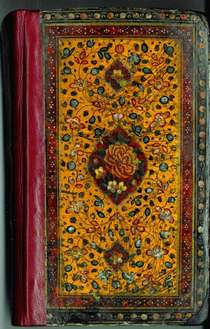
The textual structure of the Qur’an is non-systematic, and therefore extremely composite. It contains the fundamentals of Islamic belief and worship, but without any strict order or detail. The need to clarify many Qur’anic passages for the faithful themselves, together with the need to standardise the life of Islamic communities according to clear rules, led Muslim scholars to produce an endless harvest of theological essays and to systematise the prohibitions, rules and recommendations contained in the Qur’an into veritable schools of law, at the same time investigating the very life, sayings, deeds, inclinations (and omissions) of the Prophet Muhammad, on whom, according to Muslims, the Book “descended” in “clear” Arabic as an unexpected and gratuitous revelation from God, through the angel Gabriel.
Since the first centuries of Islam, exegetes have been interested in solving the problem of a chronological classification of the Surahs that would be as rigorous as possible, applying the disciplines of logic, rhetoric, and philology to the text of the sacred book – in a similar way to what had already been done, at least in part, for the Hebrew Bible and the Christian Gospels.
The Islamic Manuscript
The Islamic civilisation has always paid the greatest attention to the practice of beautiful writing, namely calligraphy. This art has been the object of great study and veneration since the early days of Islam, eventually reaching heights of admirable beauty.
At first glance, the Arabic manuscript bears many similarities and few characteristic differences with the medieval European manuscript. The Arabic alphabets, for example, unlike the Latin scripts, write from right to left, which makes it necessary to bind the Arabic book on the right side instead of the left, and to leaf through it in the mirror image of Western medieval manuscripts.
As in the West, the most widely used writing material for Arabic books was initially parchment, which in the Islamic world was almost completely supplanted quite soon, by the introduction of paper, invention of Chinese origin. In the East, parchment continued to be used just until the 10th/11th centuries, while in the West, it remained the most widely used writing material between the early Middle Ages and the 11th/13th centuries, when paper made its appearance in Europe via the Muslim world and, albeit more slowly, established itself once and for all.
The “Western” paper was produced by macerating textiles, while the “Eastern£” paper was of vegetable origin.
The main instrument of Arabic writing was the calamus (in Arabic qalam, a word derived in turn from the ancient Greek kàlamos), made from a cane stick with one end cut according to various techniques, then pointed. The inks used for writing were either carbon or metal-gallic, but mixtures of both were also known and employed.
Islamic bindings had distinctive features as well. From a decorative point of view, the most characteristic elements were the book flap, as well as a central almond-shaped medallion, technically called mandorla, which from the 13th century onwards became the most frequent motif.
The miniature
Many Middle Eastern Islamic codices, like their Western counterparts, were richly illuminated.
When we speak of Islamic illuminated manuscripts, we are always referring to non-Qur’anic manuscripts, since representations of living beings were, at least in religious books, strictly forbidden.
It seems that the first Arabic illuminated manuscript date back to the 12th century, while the oldest known codex containing geometric diagrams and astrological figures should be dated at the beginning of the 11th century. The decoration of scientific texts dealing with astronomy, mathematics or botany played an important role in the development of the art of Islamic miniature.
Speaking of Islamic miniatures, we are referring mainly to the Persianate (and later Ottoman) world, as this artistic phenomenon was born and developed itself in that area starting from the 14th to the 17th century.
The first school of painting can be considered that of Baġdād, which arose in the 13th century. When, in the middle of the century, this great cultural centre was destroyed by the Mongol army (1258 AD), Chinese art burst onto the scene, strongly influencing Persian artists, who were nevertheless able to elaborate autonomous styles and artistic languages, founding important schools such as those in Tabrīz (13th – 14th century), Šīrāz and Herāt (14th – 15th century).
Among the most important artists of these schools are the great Behzād (Herāt and Tabrīz, late 15th century) and Reżā ͨAbbāsī of Eṣfahān, among many others.
As within the contemporaneous European atélier, the art of book decoration in the Islamic workshops was the elaborate result of teamwork. The master at the head of the workshop supervised the artistic realisation of the whole work and painted the most significant parts of the miniatures, while his pupils and assistants were entrusted with all the minor components of them. As was the case in Europe, especially for the lavishly illuminated “Books of Hours”, which became authentic status symbols, book decoration gave proof of the client’s political and social status also through the Islamic world.
During the 16th century, the Islamic Mughal dynasty arose in northern India. They borrowed courtly culture, language, and artistic techniques from Muslim Persia, thus giving generous patronage for the realization of sumptuously illuminated manuscripts.
By the 14th century, Persian had become the lingua franca of the vast geographical area stretching between China and Turkey.
Through the gradual integration of Persian artistic models, Indian local traditions, and various European influences, the “Mughal style” was formed, reaching its zenith during the first half of the 17th century. The reigns of two great emperors, Akbar (1556 - 1605 AD) and his son Jahāngīr (1605 - 1627 AD), defined the salient phases of this style.
The Persianate world
Persia is homeland to the ancient empire founded by Cyrus the Great during the 6th century BC.
Unlike Arabic, which is a Semitic language, Persian was an ancient Indo-European idiom, like Sanskrit and Latin. However, following the Islamic conquest of Persia, the Persian language incorporated a sheer number of Arabic loanwords, and began to be written in a slightly modified Arabic alphabet. This phase in the history of the Persian language came to be known as “Neo-Persian”, the forerunner of what nowadays is Fārsī.
The contribution of Persian scholars to the definition and progress of Islamic civilisation was decisive in every field of knowledge. However, if Arabic was the language of Islamic faith and science, the pinnacles of poetry and literature “spoke Persian”.
The classical era of Persian literature covers the centuries from the 11th to the 15th. The Šāhnāmeh, or “Book of Kings”, is Iran's national epic, the masterpiece of the bard of Neo-Persian poetry, Ferdowsī, who ended its poem one thousand years ago now.
Between Persia and Azerbaijan Nezami of Gangeh (1141 – 1209 ca.) composed elegant chivalric and mystical poems. In the Persian East, also called Korashan, Sufism sang its depths by the long poems of Attar (1145/46 - 1221), while Rumi, the former’s spiritual heir, composed his monumental poem Matnavi-ye Masnavi (“The Spiritual Couplets”), which was later called “a Quran in Persian verses”. In Shiraz were born the two great poets Saadi and Hafez, who represented the pinnacle of Persian lyricism. Finally, the last among the Persian classical authors was Jami (1414 – 1492), who lived at the magnificent court of the last Timurid rulers, and wrote his poetry, in Herāt, then important centre of Persian literature and seat of a celebrated school of miniaturists.



